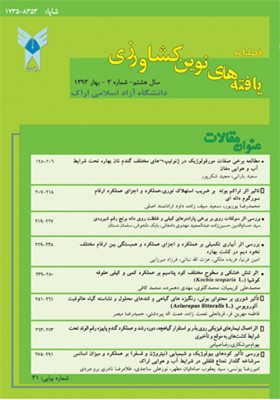تعیین مناسبترین تاریخ کاشت و رقم جو دیم برای کشت در منطقه همدان
محورهای موضوعی : یافته های نوین کشاورزیجواد حمزه ئی 1 , افشار آزادبخت 2 * , سید محسن سیدی 3
1 - دانشیار گروه زراعت و اصلاح نباتات دانشکده کشاورزی دانشگاه بوعلی سینا همدان
2 - دانش آموخته دکتری علوم علفهای هرز دانشگاه محقق اردبیلی
3 - دکترای اکولوژی گیاهان زراعی، دانشکده کشاورزی دانشگاه بوعلی سینا همدان و عضو باشگاه پژوهشگران جوان دانشگاه آزاد اسلامی واحد همدان
کلید واژه:
چکیده مقاله :
هدف از انجام این آزمایش مطالعه تاثیر تاریخ های کاشت مختلف 15 مهر، 15 آبان و 15 آذر بر رشد، عملکرد و اجزای عملکرد پنج رقم جو محلی همدان (شاهد)، آبیدر، والفجر، بهمن و ماکویی بود. آزمایش به صورت فاکتوریل بر پایه بلوک های کامل تصادفی در سه تکرار در ایستگاه تحقیقات کشاورزی دانشگاه بوعلیسینا همدان انجام شد. در این تحقیق ارتفاع بوته، تعداد سنبله در متر مربع، تعداد دانه در سنبله، وزن هزار دانه، عملکرد دانه، عملکرد بیولوژیک و شاخص برداشت ارزیابی شدند. نتایج نشان داد، بیشترین عملکرد دانه (82/420 گرم بر مترمربع) در تاریخ کاشت اول به دست آمد. همچنین بیشترین عملکرد بیولوژیک (33/906 گرم بر مترمربع) در تاریخ کاشت 15 مهر ماه حاصل شد. بین ارقام جو از نظر عملکردهای دانه و بیولوژیک تفاوت معنی دار وجود داشت. رقم والفجر با میانگین 83/382 گرم در مترمربع بیشترین عملکرد دانه را تولید نمود و این رقم با سایر ارقام تفاوت معنی دار داشت. اثر متقابل تاریخ کاشت در رقم تنها بر صفت تعداد دانه در سنبله معنی دار بود. در این بررسی مناسب ترین تاریخ کاشت و رقم جو برای منطقه همدان تاریخ کاشت 15 مهر ماه و رقم والفجر شناخته شد.
The aim of this research was to study the effect of planting dates of 6 Oct., 5 Nov. and 5 Dec., 2013 as S1, S2 and S3 treatments, respectively, on growth, yield and yield components of five barely cultivars (C1; Mahally as a control, C2; Abidar, C3; Valfagr, C4;Bahman and C5; Makoyei). A factorial experiment was done based on randomized complete block design with three replications at the Agricultural Research Station of Bu- Ali Sina University. Traits of plan height, number of spike m-2, number of grain spike-1, 1000- seed weight, grain yield, biological yield and harvest index (HI) were evaluted. Results showed that planting date treatment had significant effects on all traits. Maximum grain yield (420.82 g m-2) was attained at S1 treatment. S3 treatment in comparison with S1 treatment decreased grain yield up to 46.5%. At the late planting date (S3) due to exposure of plants with heat and drought of late season, grain yield of barley decreased. Also, maximum biological yield (906.33 g m-2) was achieved at planting date of 6 Oct. (S1). Between barley cultivars for traits of grain and biological yields was different significant. Valfagr cultivar with average of 382.83 g m-2, produced the highest value of grain yield and this coutivar had significant difference with other cultivars. The interaction of planting date × cultivar was significant only for grain number spike-1. Maximum and minimum values for grain number spike-1 were achieved at S1×C3 and S3×C1 treatments, respectively. In this study the most suitable planting date and barley cultivar for Hamadan region was determine planting date of 6 Oct. and Valfajr cultivar.

